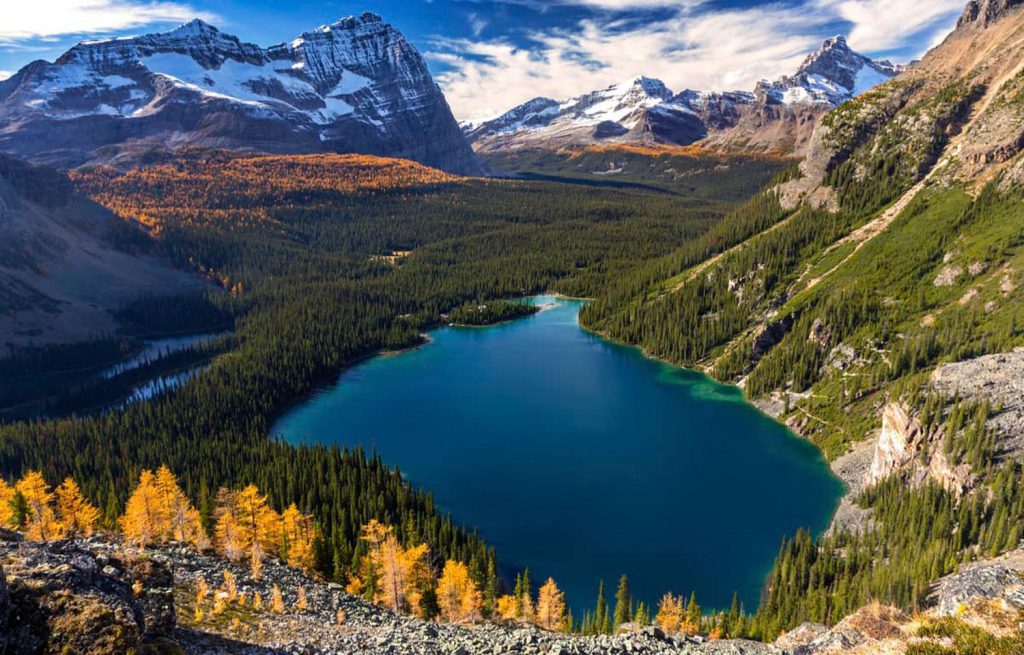Content
- 1 History of Yoho National Park
- 2 Location and How to Get to Yoho National Park
- 3 Landscape and Geology of Yoho National Park
- 4 Flora and Fauna of Yoho National Park
- 5 Top Attractions and Points of Interest in Yoho National Park
- 6 Recreational Activities in Yoho National Park
- 7 Tips and Recommendations for Visitors
- 8 Conservation and Management of Yoho National Park
- 9 How to Get Involved and Support Yoho National Park
- 10 Photo Gallery
Located in the heart of the Canadian Rocky Mountains, Yoho National Park is a gem of nature that shines with its mighty beauty. This guide will take you on an unforgettable journey through this astounding park, where you will discover everything from eternal glaciers and towering waterfalls to unique flora and fauna found nowhere else in the world.
History of Yoho National Park
Established on October 10, 1886, Yoho National Park has been fascinating visitors for over a century. The name ‘Yoho’ comes from an expression in the Chippewa-Cree language, meaning "awe and wonder", perfectly reflecting the impact this Canadian park has on its visitors as they explore its 1,313 km². It can be geolocated at coordinates: 51°23′43.08″ N, 116°29′13.2″ W.
Location and How to Get to Yoho National Park
Located in the province of British Columbia, the park is accessible via the Trans-Canada Highway. It’s approximately a three-hour drive from the city of Calgary to the park entrance.
Landscape and Geology of Yoho National Park
Yoho is a paradise for nature lovers, with an impressive variety of geological and natural landscapes.
Mountains
The mighty mountains of Yoho National Park, some reaching heights of over 3,000 meters, offer unparalleled panoramic views.
Glaciers
Glaciers, like the Daly Glacier, are an essential part of the park’s landscape. Their presence bears witness to the park’s geological past and offers an opportunity to get up close to these icy giants.
Waterfalls and Rivers
The park is home to several spectacular waterfalls and rivers, including Takakkaw Falls, one of Canada’s tallest waterfalls, and the Kicking Horse River, famous for its rapids.
Flora and Fauna of Yoho National Park
The park is home to a rich variety of wildlife and vegetation.
Iconic Species
Visitors have the chance to spot black bears and grizzlies, moose, wolves, and many other species. Additionally, the park is a birdwatcher’s paradise, with over 180 recorded species.
Diversity of Plants
The vegetation ranges from coniferous forests to alpine meadows, offering a colorful display throughout the year.
Top Attractions and Points of Interest in Yoho National Park
There are many must-visit attractions in the park that will satisfy all types of travelers.
Lake Emerald
Lake Emerald is the jewel of the park, famous for its stunning turquoise waters reflecting the surrounding mountains. A must-visit spot for nature lovers.
Waputik Icefield
This vast icefield is the source of some of Canada’s most significant rivers and offers a unique glacier-watching experience.
Takakkaw Falls
With a total drop of 373 meters, Takakkaw Falls is a breathtaking spectacle and one of Canada’s tallest waterfalls.
Yoho Park Road
A journey along the Yoho Park Road provides panoramic views of some of the park’s most stunning landscapes.
Burgess Shale
The Burgess Shale fossil bed, declared a UNESCO World Heritage Site, offers a unique window into the park’s geological past.
Recreational Activities in Yoho National Park
The park offers a wide variety of activities for all skill levels and adventure seekers.
Hiking and Mountaineering
With over 400 km of trails, there is a route for everyone, from short and easy hikes to multi-day alpine expeditions. Hiking is one of the best ways to experience the park’s beauty.
Canoeing and Fishing
The park’s lakes and rivers offer excellent opportunities for canoeing and fishing, with the Kicking Horse River being a popular spot for rafting.
Photography and Nature Observation
The park is a paradise for photographers and nature enthusiasts, with its stunning landscapes and abundant wildlife.
Camping and Accommodation
There are various accommodation options within and near the park, ranging from campgrounds to lodges and hotels.
Tips and Recommendations for Visitors
Visiting Yoho National Park can be an incredible experience, but it’s important to plan ahead to make the most of your visit.
Best Time to Visit
While the park is open year-round, the best time to visit is between June and September when all roads and trails are open, and the weather is warmer. Keep in mind that Yoho’s average temperature is 12.5 degrees Celsius, with highs of 20°C and lows of 5°C.
How to Prepare for Your Visit
Remember to bring appropriate clothing for the weather, drinking water, and a map or GPS. Respect nature and follow park regulations to ensure a safe and enjoyable visit.
Conservation and Management of Yoho National Park
Yoho National Park is managed by Parks Canada, whose mission is to protect and preserve this valuable ecosystem. Various conservation initiatives are carried out to maintain the park’s integrity, including species monitoring programs, habitat restoration, and environmental education.
How to Get Involved and Support Yoho National Park
If you want to contribute to the preservation of this wonderful park, there are several ways to get involved and support its conservation. You can participate in volunteering activities organized by Parks Canada, join local conservation groups, or make donations to organizations dedicated to protecting national parks.
Explore and enjoy Yoho National Park responsibly, following minimum impact practices, and respecting park regulations. By doing so, you will be contributing to ensuring that future generations can enjoy the beauty and wonder of this unique place on Earth.
